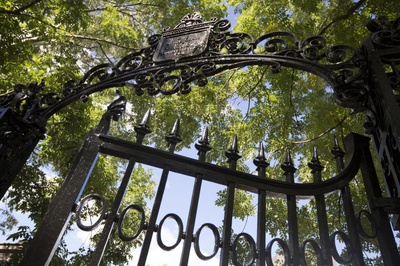
News
News Flash: Memory Shop and Anime Zakka to Open in Harvard Square

News
Harvard Researchers Develop AI-Driven Framework To Study Social Interactions, A Step Forward for Autism Research

News
Harvard Innovation Labs Announces 25 President’s Innovation Challenge Finalists

News
Graduate Student Council To Vote on Meeting Attendance Policy

News
Pop Hits and Politics: At Yardfest, Students Dance to Bedingfield and a Student Band Condemns Trump
Getting Something-for-Nothing Through Harvard
Most hackers don't have to write papers during finals; all they do is chew endless no-doz's and hand in final computer programming projects. Unfortunately, the Happy Hacker made the mistake of being a Social Studies major and was thus saddled with numerous papers and exams during January; thus the temporary disappearance of this column.
In the high-priced world of personal computers, something-for-nothing is rare. But, for almost no cost it is possible to obtain thousands of public domain games, utilities and other programs, without breaking copyright laws. Amateur and professional programmers often write small programs which they don't want to sell. Instead, they offer these programs free of charge, to any interested computer users who can find them.
At Harvard, public domain software for the Macintosh, and IBM compatibles is readily available through the Harvard Computer Society users' groups and on the large mainframes in the Science Center.
The easiest way to get public domain software is to copy it from friends. But, for those with few software-rich friends, the Happy Hacker can provide a basic lesson in where and how to obtain free software.
Where to Log-in
First, it is important to be able to connect a personal computer to the Science Center's mainframe. For those without accounts on the mainframe, it is possible to get a free low-priority account on class 4 (HUSC4) by stopping by the user services office in the Science Center's East terminal room.
The next important step to logging-in is obtaining a communications program. Macintosh owners can purchase MacTerminal or can obtain programs such as Red Ryder from other Mac users (Red Ryder is semi-public domain; instead of being sold in stores, the author expects users to send in a fee if they plan to use the program).
IBM users can obtain a copy of Kermit for $5 from the Science Center supply room, or can get a more sophisticated program such as Procomm (similar in cost to Red Ryder) from friends. Those unable to obtain a terminal program from other sources should send a blank disk to the Happy Hacker at 14 Plympton St. and wait about a week for delivery.
For users without modems (but with terminal programs), the East terminal room contains a few IBM's connected to the mainframes, and all of the Macintoshes in the Mac programming room are connected to Harvard's computer network. However, these computers are normally reserved for students in classes, and they always have priority.
Once logged on to Class 4, IBM users should type FTP HUSC6 and Macintosh users should type FTP SUMEX-AIM.ARPA. FTP is a program which enables users to hook-up to other computer system; in this case HUSC6 which contains the Harvard Computer Society's Public Domain software library and SUMEX which has thousands of Macintosh programs.
FTP will ask you to sign-in. Type ANONYMOUS for your user id, and type username for your password. Once connected to the remote system, a couple of commands are necessary to examine and transfer programs. First, LS prints out the directory of files. CD changes the directory level, so that other files can be accessed.
IBM users should type CD /ibmpc/isib. Typing LS will then provide a list of sub-directories (such as GAMES, DOC, etc.) typing CD and then the sub-directory name will then move the user to that directory. Type GET filename to copy a file you are interested in into your mainframe directory. Typing GET program-library list will give you a list of many of the available programs. Now program-library. list can be typed out with the CAT filename command (similar to TYPE from MS-DOS).
MAC users connected to SUMEX should type cd info-mac. Any files with a .HQX extension are actual Macintosh files; other listings are directories which can be entered and examined with the CD and LS commands respectively.
After GETing all of the files you are interested in, it is necessary to transfer them from the mainframe to your computer. From a Class 4 account, Mac users simply type MACPUT filename and then set their communications program to receive a file. When the program has been put onto a Mac disk, it will need to be converted with a program called BINHEX (available from hacker friends).
IBM users can use a program such as Kermit. Type KERMIT on the mainframe and then type SERVER to put Kermit under the control of the PC's terminal program. From there follow Kermit's help file to put the program onto an IBM compatible disk.
Want to keep up with breaking news? Subscribe to our email newsletter.
Most Read
- As Garber Stands Against Trump, Money From Harvard Donors Pours In
- DHS Threatens To Revoke Harvard’s Eligibility To Host International Students Unless It Turns Over Disciplinary Records
- Harvard Dismantled the Program That Changed My Life
- Harvard School of Public Health Begins Layoffs As Trump Slashes Funding
- When They Go Low, We Go DEI
From Our Advertisers

Over 300+ courses at prestigious colleges and universities in the US and UK are at your disposal.

Where you should have gotten your protein since 1998.

Serve as a proctor for Harvard Summer School (HSS) students, either in the Secondary School Program (SSP), General Program (GP), or Pre-College Program.

With an increasingly competitive Law School admissions process, it's important to understand what makes an applicant stand out.

Welcome to your one-stop gifting destination for men and women—it's like your neighborhood holiday shop, but way cooler.

HUSL seeks to create and empower a community of students who are seeking pathways into the Sports Business Industry.
